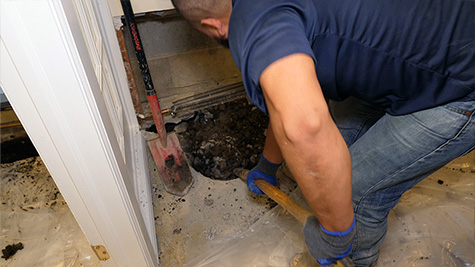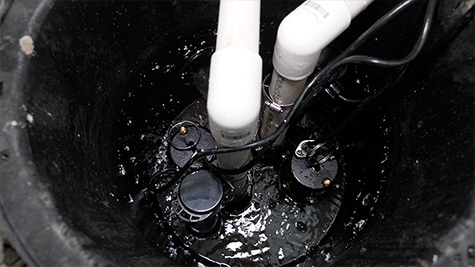Adding a Sump Pump to an Existing Basement

Share this Post
Adding a sump pump to an existing basement can be a worthwhile project for homeowners who want to improve the functionality and value of their homes.
A sump pump is a device installed in a pit or basin in the basement, and it pumps water out of the basement to prevent flooding and water damage.
If you have a basement and are considering adding a sump pump, there are a few things you need to know. This article will walk you through adding a sump pump to your basement from start to finish.
Table of Contents
Step 1: Determine If You Need a Sump Pump
Before adding a sump pump to an existing basement, it’s essential to determine if you need one. A sump pump might not be necessary if your basement has never flooded or experienced water damage. However, a sump pump could be a valuable addition to your home if you have a history of flooding or water issues in your basement.
To determine if you need a sump pump, consider the following factors:
Location
Is your home in an area prone to heavy rainfall or flooding? If so, a sump pump might be a good idea.
Water Table and Soil Type
Is the water table in your area high? If so, water might be more likely to seep into your basement, making a sump pump more necessary.
The water table is the level at which the ground is saturated. If the water table is high, it can cause groundwater to move through underground capillaries into the softer backfill area around your house. The water will rise in the backfill area and flood basements or low-lying areas of a home.
Read about a “false water table” and how it affects your home’s foundation.

Soil type plays a crucial role in determining the amount of water that can be retained by the soil. Sandy soil has larger particles and more space between them, which allows for better drainage and less water retention.
Clay soil has smaller particles and less space between them, which leads to slower drainage and more water retention. So, clay soil collects more water than sandy soil. You can find out the type of soil in your area of Connecticut by looking at the Soil Survey Geographic provided by UCONN.
Foundation Type
Does your home have a concrete or cinder block foundation, or is it built on a crawl space or slab? Concrete block foundations are more susceptible to water damage, so a sump pump might be a good idea if you have this type of foundation.
Step 2: Choose a Sump Pump
Once you’ve determined that you need a sump pump, it’s time to choose the right one for your home. There are several types of sump pumps to choose from, each with its pros and cons.
Pedestal Sump Pumps
These pumps are mounted on a pedestal and are more affordable than other sump pumps. However, they are also louder and less reliable than other options.
Submersible Sump Pumps
These pumps are completely submerged in the sump basin and are much quieter than pedestal pumps. They are also more reliable, but they are also more expensive.
Battery-Operated Sump Pumps
These pumps use a battery as a backup power source, making them a good choice for homes prone to power outages.
When choosing and adding a sump pump, consider the size of your sump pit, the volume of water that needs to be pumped, and the horsepower of the pump. You’ll also want to consider the warranty and customer service offered by the manufacturer.
Step 3: Install the Sump Pump and Discharge Pipe
Installing a sump pump and discharge pipe involves several steps, including digging a sump pit, installing a basin and the pump, and connecting the discharge pipe.
Here is a more detailed breakdown of these steps:
Dig a Sump Pit

The first step is to dig a hole in the lowest part of your basement, where water tends to collect. The pit should be large enough to accommodate the basin, sump pump, and any additional equipment you might need. A sump pump basin is a perforated container that sits in the sump pit and helps to collect groundwater for the sump pump.
Install the Sump Pump Basin
You’ll need to place the sump pump basin in the pit before adding a sump pump. Make sure the basin is positioned correctly and that it’s secure.

Install the Sump Pump
Once the basin is in place, you’ll need to install the sump pump according to the manufacturer’s instructions. This typically involves connecting the pump to a power source and securing it in the basin.
Connect the Discharge Pipe
The discharge pipe is the pipe that carries the water out of the basement. You’ll need to connect the discharge pipe to the sump pump and run it to the outside of your home. It’s important to ensure the discharge pipe is properly sealed to prevent leaks.
Step 4: Test the Sump Pump

After adding a sump pump and discharge pipe, it’s important to test the system to ensure it’s working properly. To do this, you’ll need to simulate a flood by pouring water into the sump basin. The sump pump should turn on and start pumping the water out of the basement.
If the sump pump doesn’t turn on or is not pumping water out of the basement effectively, there may be an issue with the installation or the pump itself. In this case, you’ll need to troubleshoot the problem and make any necessary repairs.
Step 5: Maintain the Sump Pump
A sump pump is an essential investment in your home, and it’s important to ensure it lasts many years. Here are a few tips for maintaining your sump pump:
Test the Sump Pump Regularly
It’s a good idea to test it every few months to ensure it’s working properly.
Clean the Sump Pump Basin
Over time, debris and sediment can accumulate in the sump pump basin. It’s essential to clean these regularly to ensure the sump pump can function effectively.
Replace the Battery Backup
If you have a battery-operated sump pump, it’s important to replace the battery every few years to ensure it’s always ready to go in case of a power outage.
Check the Discharge Pipe
Make sure the discharge pipe is clear and functioning properly. If the pipe becomes clogged or damaged, it can prevent the sump pump from working effectively.
Conclusion
Adding a sump pump to your existing basement can be a valuable home improvement project that helps to prevent water damage and flooding. By following these steps and properly maintaining your sump pump, you can enjoy the peace of mind that comes with knowing your basement is protected from water damage.
Schedule a free, no-obligation inspection and quote at no cost.